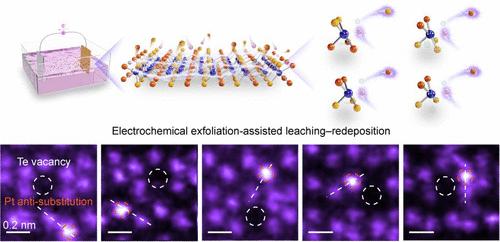原子分散催化铂在二碲化钼中的抗取代
IF 15.6
1区 化学
Q1 CHEMISTRY, MULTIDISCIPLINARY
引用次数: 0
摘要
原子缺陷,如空位、取代和掺杂,由于引入异常电荷态和非中心对称畸变,在决定二维(2D)材料的功能方面起着至关重要的作用,包括自旋玻璃、单光子发射器和能量存储和转换。特别是,反取代被认为是有前途的拓扑缺陷类型,其中取代发生在相反的电荷位置,从根本上改变原始晶格的原子和电子结构。然而,由于地层能量高、反应路径复杂,大规模反取代的制备仍然具有挑战性。在这里,我们提出了一种利用电化学剥离辅助浸出-再沉积(EELR)方法在缺陷1T ' -MoTe2中合成原子分散Pt抗取代的方法。原子分辨率扫描透射电子显微镜(STEM)成像显示,Pt原子取代Te位点,形成非常规的Mo-Pt键。通过控制电化学条件,制备了多种多样的Pt反取代构型以及Pt反取代与Te空位的偶联。密度泛函理论(DFT)计算表明,Pt原子优先占据与相邻Te空位耦合的Te空位,稳定了反取代构型。偶联Pt-Te缺陷配合物表现出优异的析氢反应,过电位仅为12.9 mV,这是因为偶联缺陷配合物引起电荷重新分布,并根据DFT提示调节活性位点的d带中心。这些发现为二维材料的原子分散抗取代工程提供了一种有效的方法,为在催化和其他先进应用中精确设计具有目标功能的原子特征提供了新的机会。本文章由计算机程序翻译,如有差异,请以英文原文为准。

Atomically Dispersed Catalytic Platinum Anti-Substitutions in Molybdenum Ditelluride
Atomic defects, e.g., vacancies, substitutions, and dopants, play crucial roles in determining the functionalities of two-dimensional (2D) materials, including spin glass, single-photon emitters, and energy storage and conversion, due to the introduction of abnormal charge states and noncentrosymmetric distortion. In particular, anti-substitutions are regarded as promising topological defect types, in which substitution occurs at opposite charge sites, fundamentally modifying the atomic and electronic structures of pristine lattices. However, the fabrication of large-scale anti-substitutions remains challenging due to high formation energies and complex reaction paths. Here, we propose an approach for synthesizing atomically dispersed Pt anti-substitutions in defective 1T′-MoTe2 using the electrochemical exfoliation-assisted leaching–redeposition (EELR) method. Atomic-resolution scanning transmission electron microscopy (STEM) imaging reveals that Pt atoms substitute Te sites, forming unconventional Mo–Pt bonds. A rich variety of Pt anti-substitution configurations and Pt anti-substitutions coupling with Te vacancies have been fabricated by controlled electrochemical conditions. Density functional theory (DFT) calculations suggest that Pt atoms preferentially occupy the Te vacancy sites coupled with neighboring Te vacancies, stabilizing the anti-substitution configurations. The coupled Pt–Te defect complexes exhibit excellent hydrogen evolution reaction, with an overpotential of only 12.9 mV because the paired defect complexes cause charge redistribution and regulate the d-band center of the active sites as suggested by DFT. These findings introduce an effective approach for engineering atomically dispersed anti-substitutions in 2D materials, presenting new opportunities for the precise design of atomic features with targeted functionalities in catalytic and other advanced applications.
求助全文
通过发布文献求助,成功后即可免费获取论文全文。
去求助
来源期刊
CiteScore
24.40
自引率
6.00%
发文量
2398
审稿时长
1.6 months
期刊介绍:
The flagship journal of the American Chemical Society, known as the Journal of the American Chemical Society (JACS), has been a prestigious publication since its establishment in 1879. It holds a preeminent position in the field of chemistry and related interdisciplinary sciences. JACS is committed to disseminating cutting-edge research papers, covering a wide range of topics, and encompasses approximately 19,000 pages of Articles, Communications, and Perspectives annually. With a weekly publication frequency, JACS plays a vital role in advancing the field of chemistry by providing essential research.

 求助内容:
求助内容: 应助结果提醒方式:
应助结果提醒方式:


